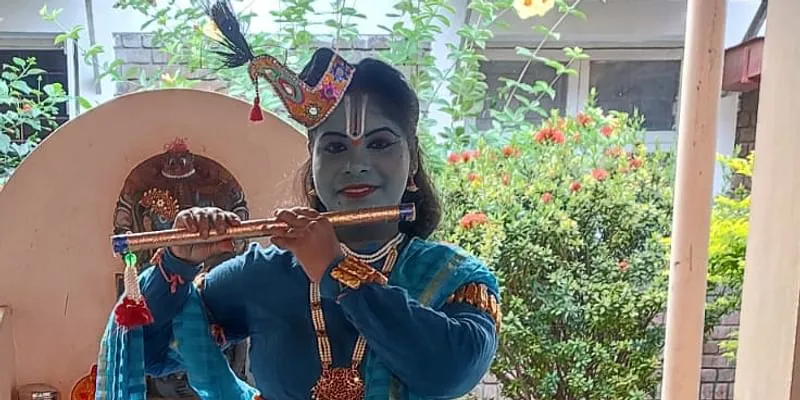Changing with time: How this folk art institute is bringing women into Kattaikkuttu
In a Kanchipuram village, a group of folk patrons are reviving the age-old performing art tradition of Kattaikkuttu by training women, and taking stories beyond mythology, which is the traditional theme.
It is rare for women to lead solo shows of Kattaikkuttu, an ancient form of rural dance-theatre performed in Tamil Nadu. Young girls and women were long looked at with disdain when it came to performing koothu, which roughly translates to folk theatre in Tamil. In Kattaikkuttu, particularly, everyone involved—the actors, singers, dancers, and musicians—have traditionally been men.
However, Bharathi A and her team of four female Kattaikkuttu performers are changing the culture.

Bharathi as Krishna
The artistes—all married and young mothers—are the only women performers at Kattaikkuttu Sangam. The 33-year-old institution in rural Kanchipuram is dedicated to keeping the rich performing art tradition, which has negligible oral transmission of knowledge, alive and thriving among the younger generation. Actor, director and playwright Perungattur P Rajagopal, together with theatre scholar Hanne M de Bruin and 15 actors and musicians, started Kattaikkuttu Sangam in 1990 as a non-profit association of professional theatre performers.
Kattaikkuttu is a rural, open-air ensemble theatre form known for its elaborate makeup and vibrant costumes, but what often goes unseen is the exuberant soundscape of music, songs, dialogue, acting, and the physically demanding movements that bring the show together, says de Bruin.
With Kattaikkuttu’s association with oppressed castes and the stigma against women inherent in the practice, the group was founded to unite performers and provide a platform for them to discuss and collaborate.
“We always saw Kattaikkuttu as a performing art tradition that deserves to be learned, irrespective of gender and caste,” de Bruin tells SocialStory.
Breaking barriers
Kattaikkuttu Sangam is the first and only institution in the country to train women in the art form.
“Girls face a number of barriers, especially when they come of age. Performing for an audience with male members is not acceptable to many. Not just women, parents of even young men fear they may not find partners for them because of the stigma attached to the theatre form and the fact it fetches an income that is uncertain and far lower than in a government job,” de Bruin notes.
“Kattaikkuttu is about body movement, body language, dialogue, and the way a large text is produced into music. That is the heart of this tradition. We wanted to show that this can be done by women artists as well, and through different kinds of stories and presentation,” she adds.
Bharathi Thamizhvanan has been learning and performing Kattaikkuttu for the last 12 years.
“When we go to other villages for performances, is it common practice for men in the village to call us ‘show women’. We tell them this is both our occupation and our heritage, and just like they earn a salary by working jobs, we earn ours through performances,” says Thamizvanan, who is famous in her community for never taking a break from performing, except a week she took off during her wedding.
Bharathi, who was raised by her grandmother, doesn't come from a family of performers. However, she grew up watching generational Kattaikkuttu artists in her village of Kvelure in Ranipet.
“I feel, in many ways, not having parents may have also helped me pursue this theatre form. I wasn't bound by any restrictions,” says Bharathi, who has been performing all-women shows regularly across the state.
Reclaiming the tradition
For Rajagopal, who comes from a family of Kattaikkuttu performers, and de Bruin, unity within the community is an important part of conserving the art.
“We wanted to create a platform where they could exchange ideas and witness each other’s performances,” says de Bruin on establishing Kattaikkuttu Sangam. Donations and local performances are sources of funding that help with the education and shows.
From 2002 to 2020, the institution offered rural children access to Kattaikkuttu training in combination with full-fledged education and comprehensive care under its flagship programme, the Kattaikkuttu Gurukulam. Despite facing hiccups, including the Gurukulam shutting down during the pandemic, the organisation has been holding a festival every year in Kanchipuram, attracting artists and enthusiasts from across the country and the world.
Thamizhvanan's elder sister Thilagavathi Palani, who learned Kattaikkuttu at the Sangam and Bharatanatyam from acclaimed artiste Sangeeta Isvaran, now runs her own Kattaikkuttu school, Sri Krishna Kattaikkuttu Kuzhu. All performers are graduates, says the 33-year-old.
“There are multiple myths we are breaking. One, that Kattauikkuttu performers are uneducated and ungraceful, and the other, that women from ‘decent’ households don’t participate in this tradition. We decided that ours would be a mixed-gender group open to men, women and transpeople,” says Palani.
The school is currently training 65 children in the folk tradition.
Palani, whose father is a veteran performer, is also exploring the art form’s intersection with social activism through subjects like child marriage, education, sexual abuse and menstrual health through shows in India and abroad.
“We like to focus on everything that makes this art form a unique and longstanding tradition of its own—the hours of makeup, the intricate costumes, and the energy and the flair that must be cultivated to translate complex stories into nightlong, seven to eight-hour performances. Instead of looking at it at the outset, this is the essence of Kattaikkuttu we try to talk about when we learn and teach. This expands the roles and prospects for enthusiasts across gender identities as they experience what it’s like to perform as artistes,” she says.
Carnatic vocalist TM Krishna joined hands with Rajagopal some years ago for ‘Carnatic-Kattaikkuttu’ performances at the Urur Olcott Kuppam Festival in Chennai and the Kattaikkuttu Sangam’s annual Performing Arts Festival in Kanchipuram.
Kattaikkuttu Sangam’s latest production is a play called Parvai’ (The Gaze), performed in a hybrid style combining elements from Kattaikkuttu and contemporary acting. “We’ve paid attention to the dramaturgy and music. It is an interracial love story set in the 19th century and against the South India Great Madras Famine of 1877-1878,” says de Bruin.
Edited by Kanishk Singh







